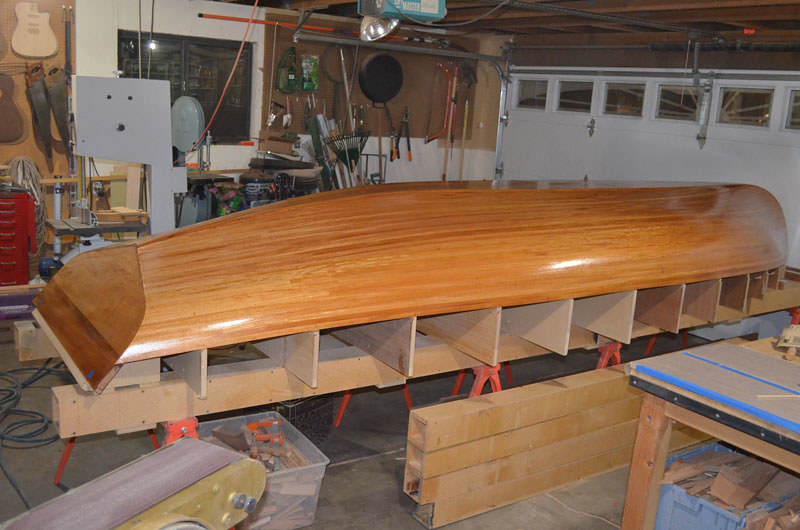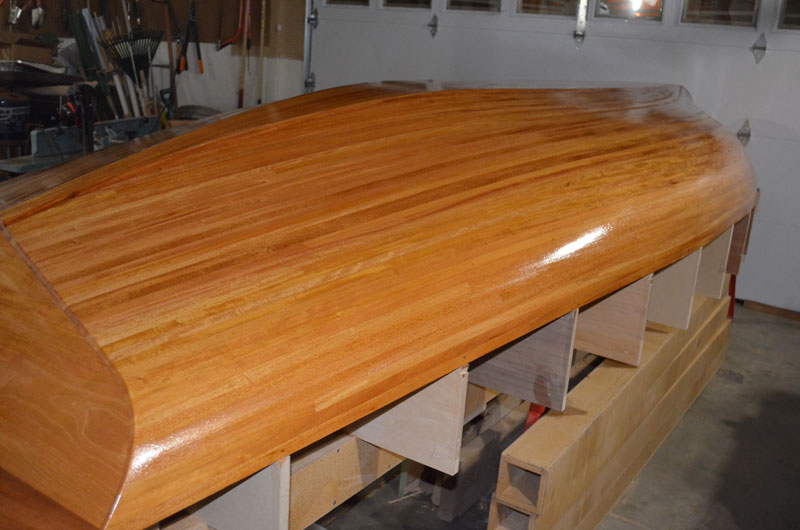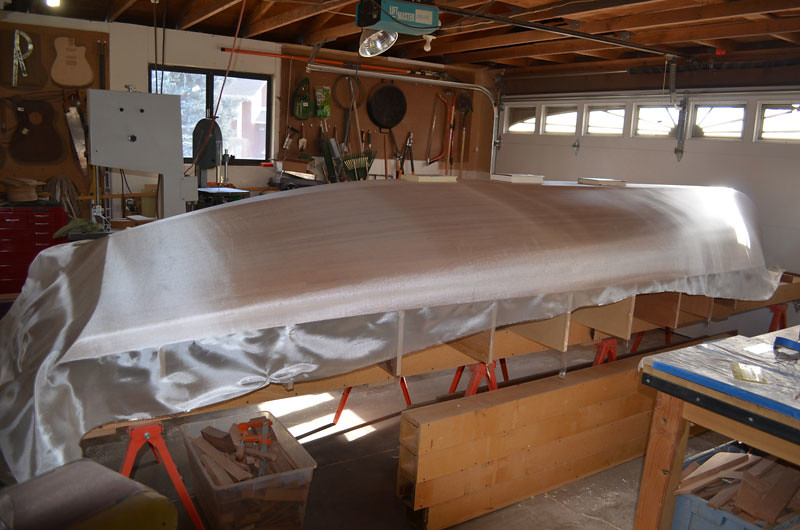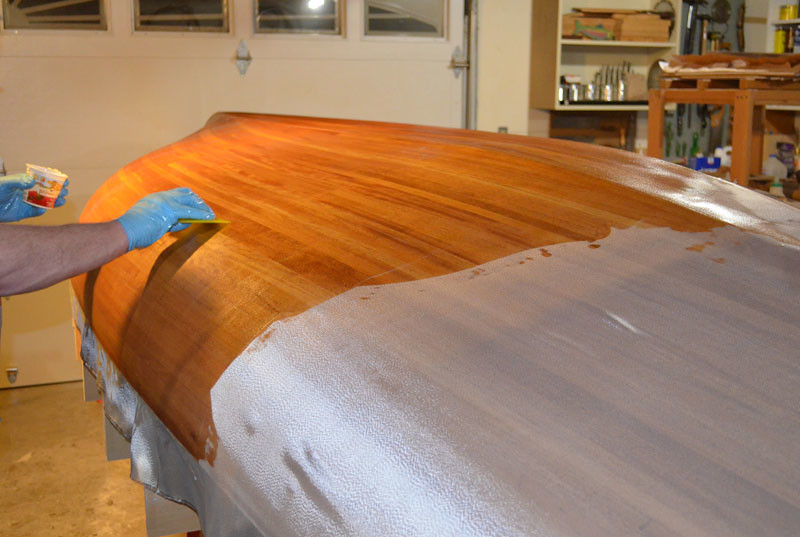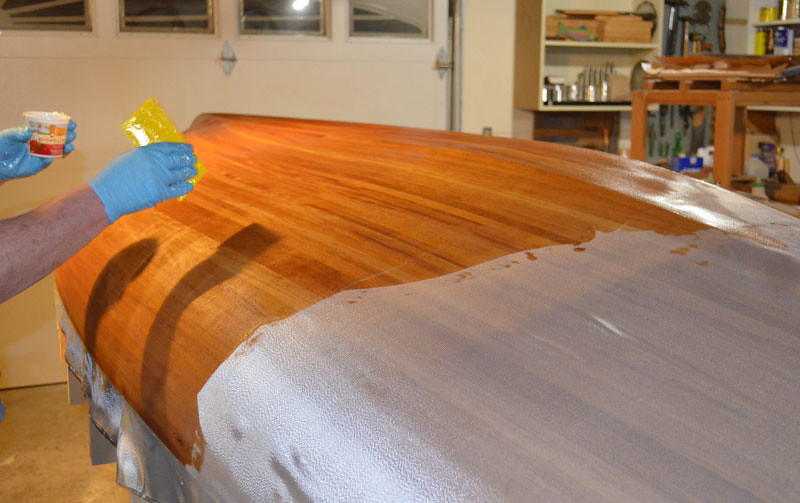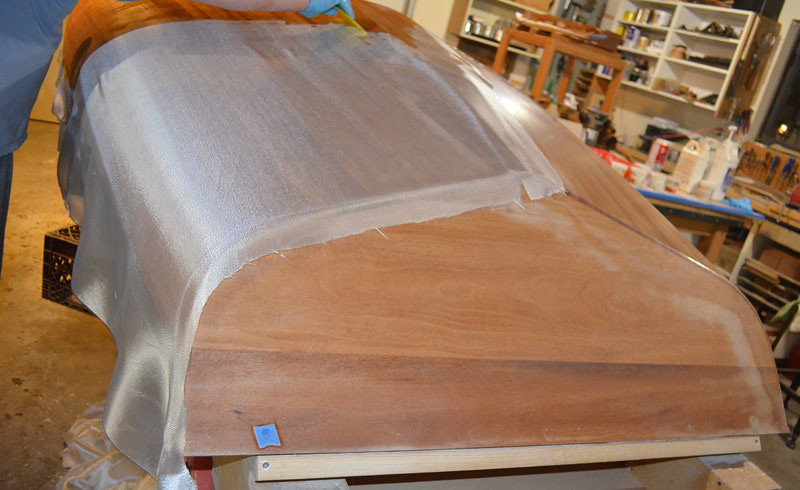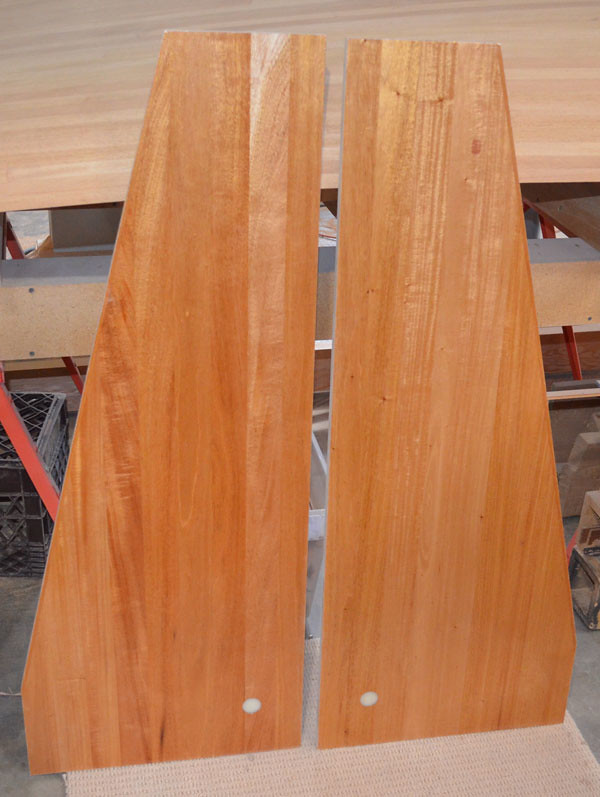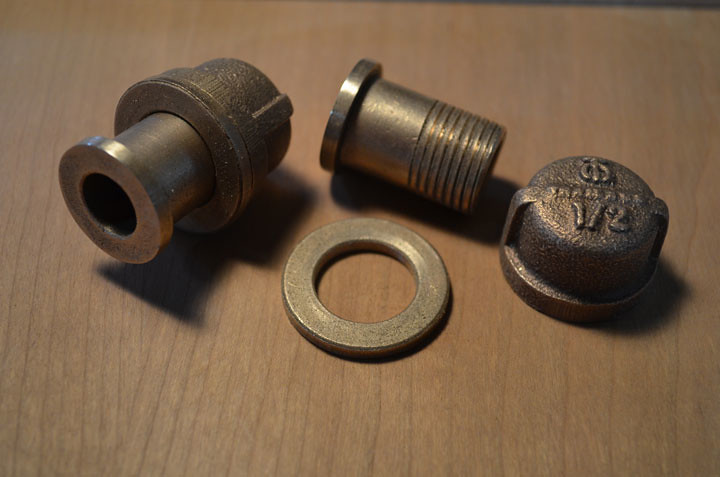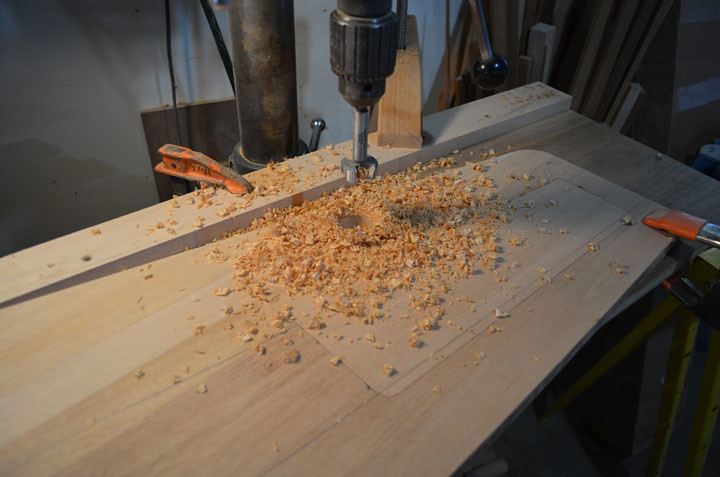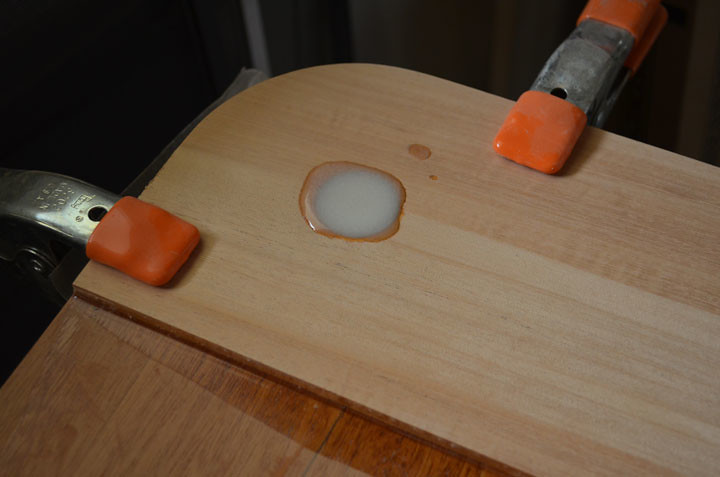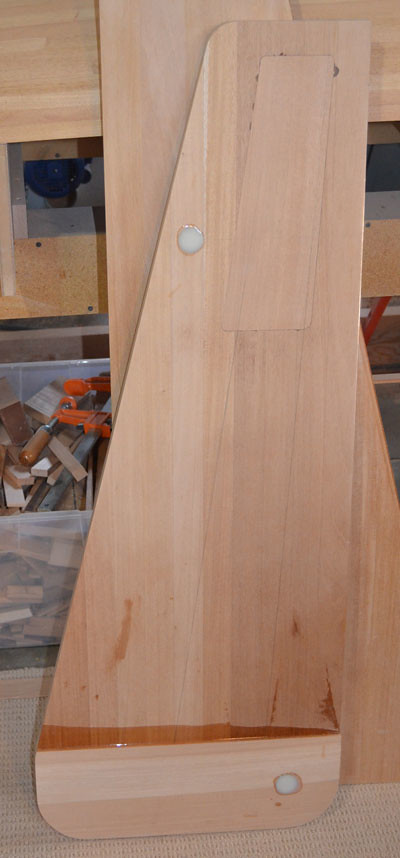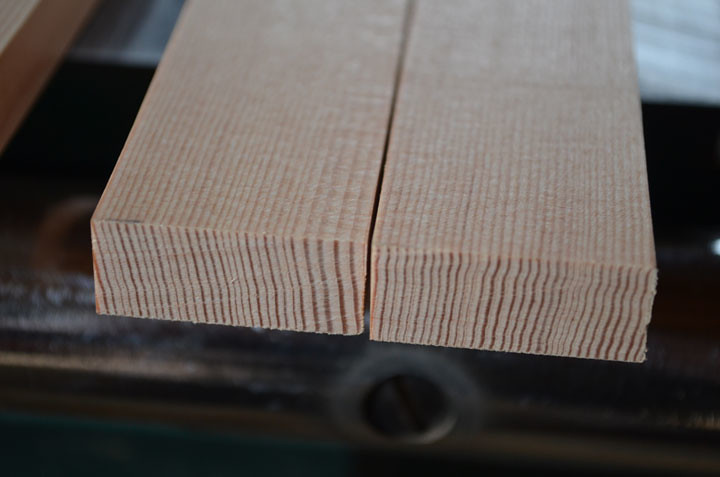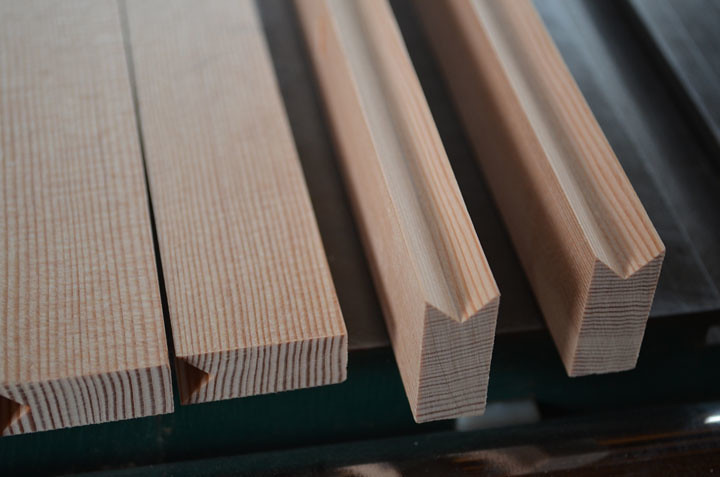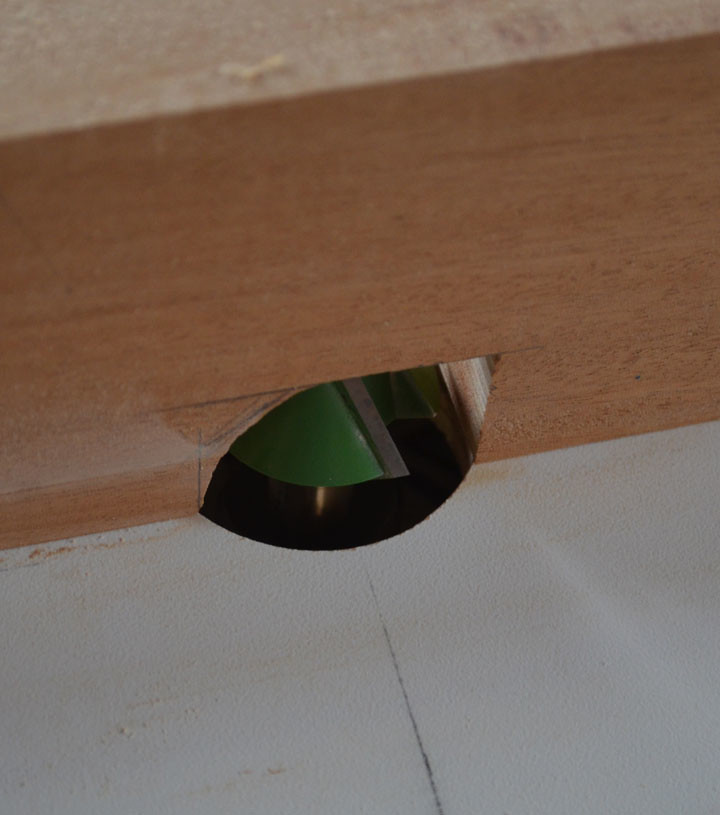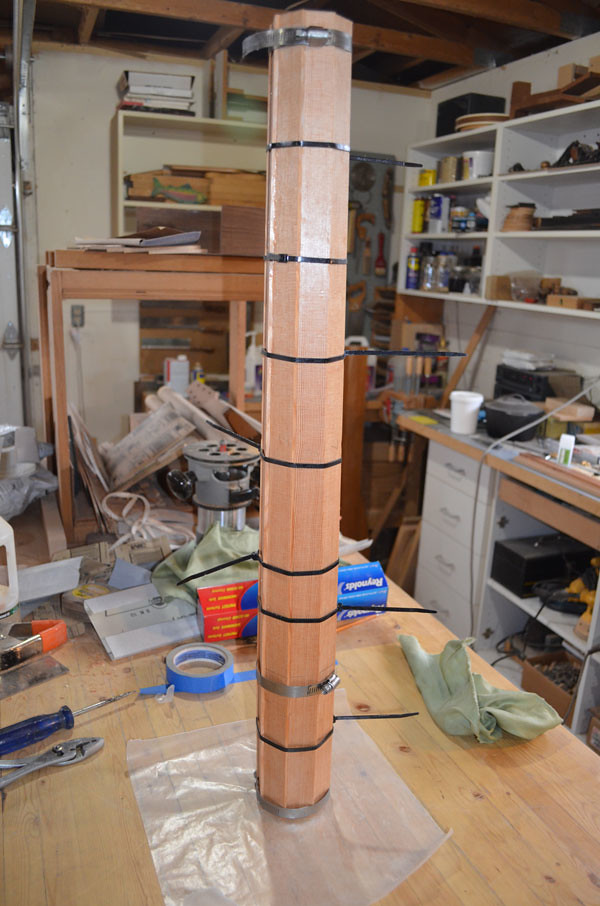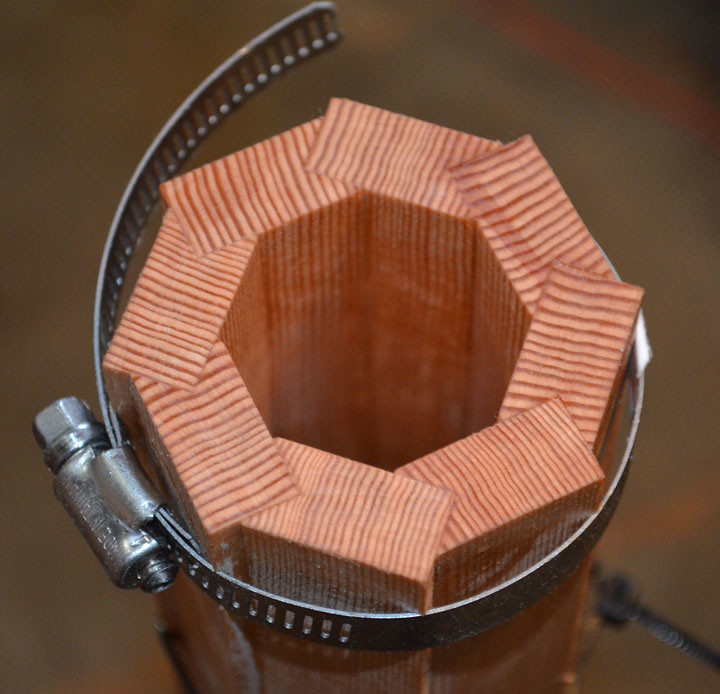Epoxy, even under the best of circumstances, is no fun to work with. However, I'm old enough to have experienced the displeasure of working with polyester resin, so I'm very happy to be using a less toxic product. This said, epoxy is plenty toxic and every precaution should be taken when using the stuff. The dust is fine and a real pain to contain. I hope to get through the fiberglass stage as quickly as possible.
I have no previous experience with fiberglass, so I spent some time reading various tutorials and watching YouTube videos on the subject. Also, a friend who is building a kayak gave me some good tips from his experience. Some folks take the extra step of sealing the wood before wet out. I like this approach because it creates a uniform snag free surface to lay the glass on and allows for less epoxy to be used during wet out. Also, after sealing the boat, you get one more opportunity to detect imperfections better dealt with before glass is applied. When I rolled on the seal coat the mahogany came to life.
I found myself second guessing my decision to paint.
The inside will be bright for sure.
I chose 6 oz glass, some folks use 10 oz, to keep the weight down. My plan is to use two 50" wide by 16' long pieces, overlapping on the bottom and chines. The 6 oz glass laid down nicely without much trouble.
I'll be glassing one side at a time, feathering the layers at the joints. The transom will be done last. The glass cloth was easier to work with than I anticipated, just make sure to use hand softener first. It is worth taking the time to smooth the fabric as much as possible before wet out.
I found a plastic trowel was the most efficient way to apply the epoxy during wet out. I just poured epoxy where needed and spread evenly with the trowel. The trowel allows fairly precise control and seems to minimize the amount of epoxy used for a given area. All the tutorials warn against applying epoxy too heavily; I tried to follow this advice. When thoroughly saturated, the cloth becomes invisible. Extra epoxy must be removed before moving to the next section. This is referred to as tipping off.
It is best to mix the epoxy in small batches so all parts of the process can be completed before it goes off. Resist the urge to mess with the finish once it starts to harden. I found 6 ounces to be about right. Everyone agrees results are best if the temperature is kept above 70 degrees during application.
The cloth extends about 4 inches beyond the far chine. Each side requires three coats to completely fill the weave. I'm wetting out the second half of the boat below. Feathering the overlapping cloth properly takes a bit of practice but, if done correctly, the joints are invisible.
The transom is covered next, allowing for two layers of glass at the edges. I'll let the epoxy shrink for a couple days, then sand it smooth before I turn her over. Guess I better get working on the skeg.
Tuesday, February 26, 2013
Monday, February 11, 2013
Odds 'n Ends
I'm chomping at the bit to to glass the hull, but the weather is just not cooperating. In the meantime, I've made some progress with the centerboard and trunk. My first experience with fiberglass and epoxy was, thankfully, uneventful. I'm using the MAS product and so far it works as advertised. I followed the instructions using 6 oz. glass with 3 coats of epoxy on the trunk parts. For the first time I can see what the mahogany will look like when finished.
My next task is to drill for the pivot hardware. I'm using two flanged bronze bearings and a 1/2" bronze rod for the pivot mechanism. I like the idea of bronze on bronze and the bearings are inexpensive, less than 3 bucks a piece at Amazon. I'll add an O-ring behind the flange and use a bronze pipe cap to seal the end and hold the bearing in place. I had to machine the NPT threads myself, not difficult as bronze is relatively soft. The bronze caps cost $5.30 a piece at Hamilton Marine Supply.
I plan to install the pivot hardware before trunk assembly to make sure everything lines up properly.
The centerboard is almost ready to shape. I added a couple pieces of mahogany to the pivot area, reducing the clearance a bit and adding some strength.
The lead cavity is covered with a wooden lid and a hole is drilled for the lanyard.
Epoxy is poured to create a waterproof seal around the pivot and the hole where the lanyard attaches.
To do; shape the foil and glass.
I originally planned on using Sitka spruce for the mast and spars. I knew it was a favored material for this purpose and I have lots of experience using Sitka for guitar tops. The problem began when I tried to source locally. No dice! I called folks on the west coast who quoted $10 a board foot for spar grade material. The price didn't faze me but the shipping charges did, more than doubling the cost. Time to rethink. Doug fir is the other preferred material and after some searching I found a local source for fine grade 12/4 fir in 18' lengths. The source was a wholesale supplier, but kind enough to let me take a look before I committed. I drove down and followed the fork lift driver to a warehouse in the very back of the complex. The warehouse was filled with Doug fir, most of it unfit for my purposes. After a bit of searching we found the good stuff and I was able to procure a near perfectly quartered 18 footer, about 8 1/2" wide and 1 7/8" thick, for $7.23 a board foot.
After staring at the board for a week or so, I broke out the power plane and circular saw to do the initial resawing. The board contained several obvious defects and some hidden ones. I did my best to work around the obvious and the rest is luck. Thankfully, the board yielded just enough material for the boom and mast. The waste included a 3' x 8" piece that I will use to test the birdsmouth technique.
From a woodworking perspective, the hollow birdsmouth style mast is an amazing thing. The procedures for building a birdsmouth mast are well documented and there are many how to tutorials available online for reference. Having no personal experience with mast building, I thought it best to do a mock up first. The mock up will be built just like the bottom three feet of the real mast, tapering from 3 to 2 1/2 inches in diameter.
The fir I'm using is very fine grained and dense, so I'm going with a wall thickness of 16%. I started with 8 pieces, like those pictured below, using the online calculator at http://www.clintchaseboatbuilder.com/resources/calculator-4.htm to obtain the correct dimensions.
The pieces are tapered and the birdsmouth is added.
You can do this on the table saw or use a router bit as I did.
Hose clamps and cable ties hold everything together while the epoxy cures.
Looks like the online calculator is accurate!
I keep thinking how lovely Doug fir would look as decking.
My next task is to drill for the pivot hardware. I'm using two flanged bronze bearings and a 1/2" bronze rod for the pivot mechanism. I like the idea of bronze on bronze and the bearings are inexpensive, less than 3 bucks a piece at Amazon. I'll add an O-ring behind the flange and use a bronze pipe cap to seal the end and hold the bearing in place. I had to machine the NPT threads myself, not difficult as bronze is relatively soft. The bronze caps cost $5.30 a piece at Hamilton Marine Supply.
I plan to install the pivot hardware before trunk assembly to make sure everything lines up properly.
The centerboard is almost ready to shape. I added a couple pieces of mahogany to the pivot area, reducing the clearance a bit and adding some strength.
Epoxy is poured to create a waterproof seal around the pivot and the hole where the lanyard attaches.
To do; shape the foil and glass.
Birdsmouth Test Case
I originally planned on using Sitka spruce for the mast and spars. I knew it was a favored material for this purpose and I have lots of experience using Sitka for guitar tops. The problem began when I tried to source locally. No dice! I called folks on the west coast who quoted $10 a board foot for spar grade material. The price didn't faze me but the shipping charges did, more than doubling the cost. Time to rethink. Doug fir is the other preferred material and after some searching I found a local source for fine grade 12/4 fir in 18' lengths. The source was a wholesale supplier, but kind enough to let me take a look before I committed. I drove down and followed the fork lift driver to a warehouse in the very back of the complex. The warehouse was filled with Doug fir, most of it unfit for my purposes. After a bit of searching we found the good stuff and I was able to procure a near perfectly quartered 18 footer, about 8 1/2" wide and 1 7/8" thick, for $7.23 a board foot.
After staring at the board for a week or so, I broke out the power plane and circular saw to do the initial resawing. The board contained several obvious defects and some hidden ones. I did my best to work around the obvious and the rest is luck. Thankfully, the board yielded just enough material for the boom and mast. The waste included a 3' x 8" piece that I will use to test the birdsmouth technique.
From a woodworking perspective, the hollow birdsmouth style mast is an amazing thing. The procedures for building a birdsmouth mast are well documented and there are many how to tutorials available online for reference. Having no personal experience with mast building, I thought it best to do a mock up first. The mock up will be built just like the bottom three feet of the real mast, tapering from 3 to 2 1/2 inches in diameter.
The fir I'm using is very fine grained and dense, so I'm going with a wall thickness of 16%. I started with 8 pieces, like those pictured below, using the online calculator at http://www.clintchaseboatbuilder.com/resources/calculator-4.htm to obtain the correct dimensions.
The pieces are tapered and the birdsmouth is added.
You can do this on the table saw or use a router bit as I did.
Hose clamps and cable ties hold everything together while the epoxy cures.
Looks like the online calculator is accurate!
I keep thinking how lovely Doug fir would look as decking.
Subscribe to:
Posts (Atom)
